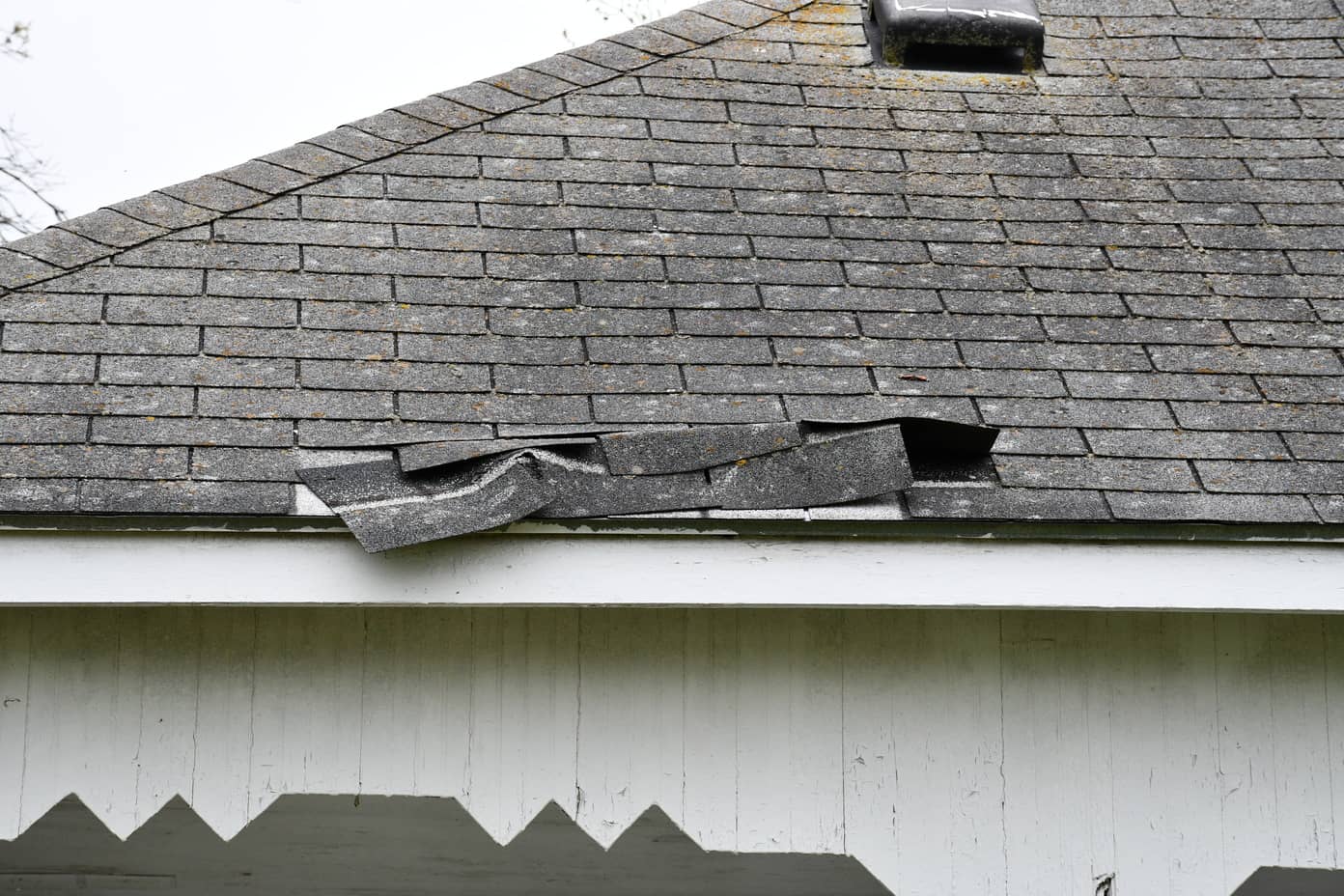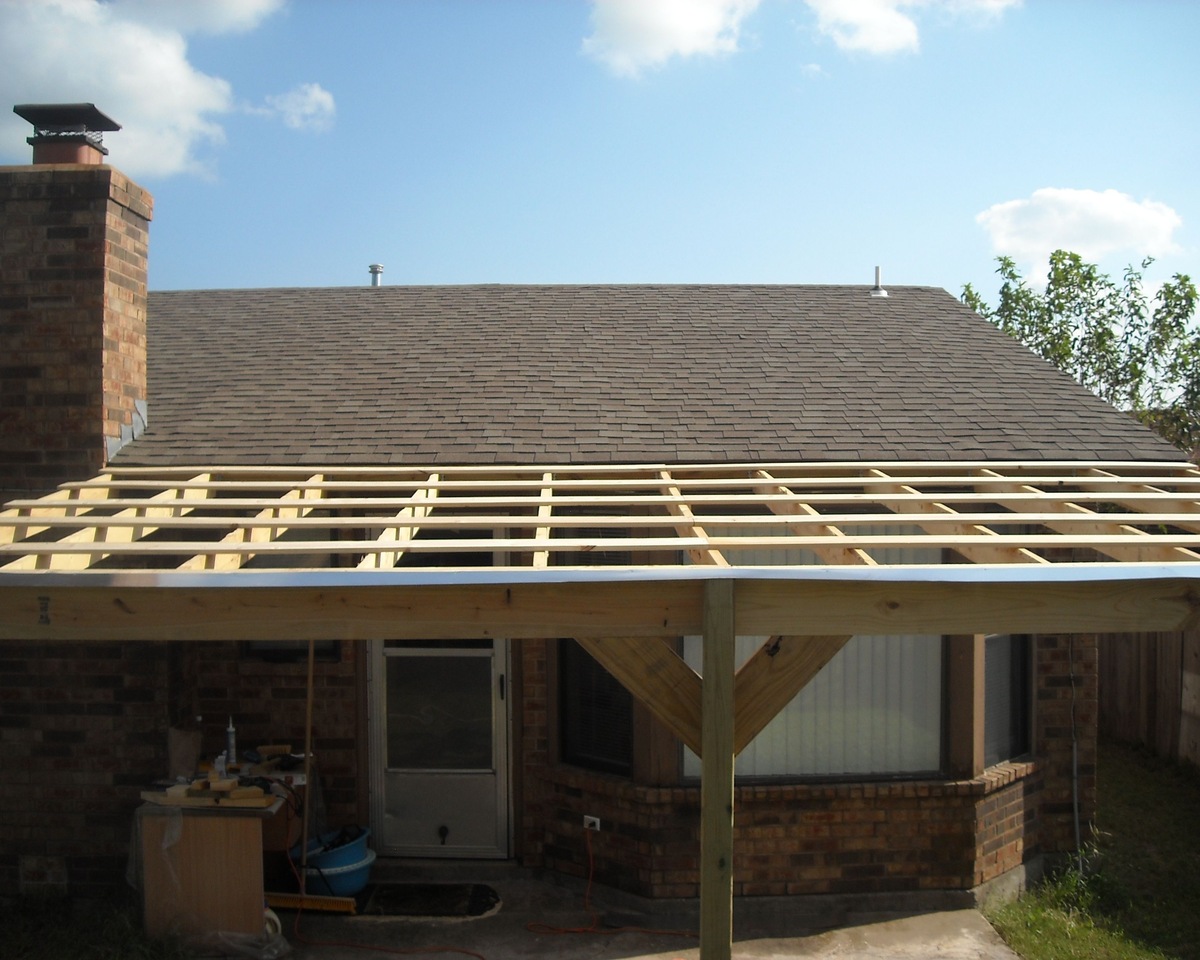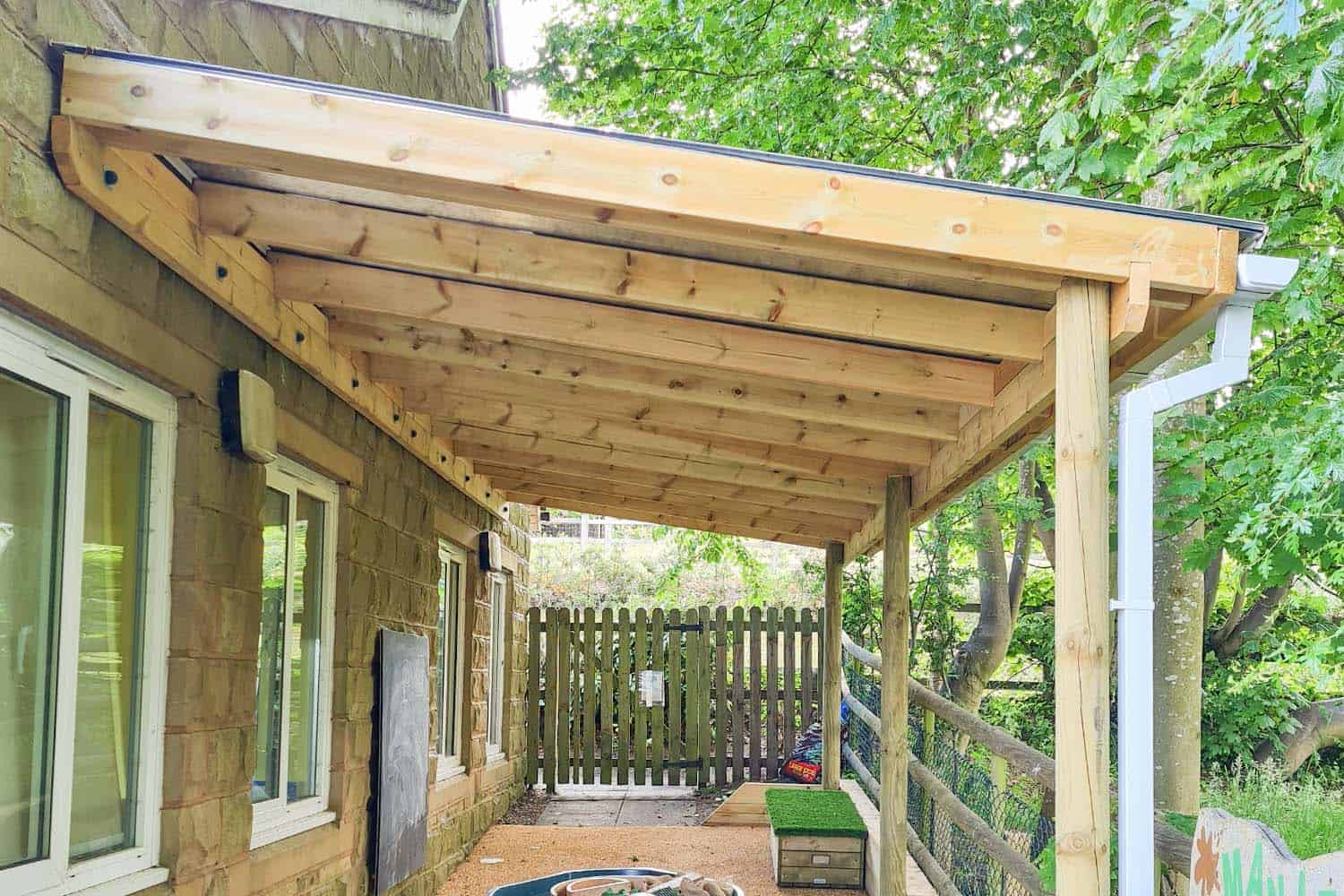

Articles
How To Pay For New Roof
Modified: October 18, 2024
Discover helpful articles and tips on how to pay for a new roof. Get insights on financing options and budgeting strategies to make your roofing project more affordable.
(Many of the links in this article redirect to a specific reviewed product. Your purchase of these products through affiliate links helps to generate commission for Storables.com, at no extra cost. Learn more)
Introduction
Having a reliable and structurally sound roof is essential for the protection and comfort of your home. However, when faced with the need for a new roof, many homeowners are often concerned about the financial aspect of such a significant investment. The cost of a new roof can vary depending on factors such as the size of your home, the materials used, and the complexity of the installation.
Fortunately, there are several ways to pay for a new roof, ranging from traditional financing options to alternative methods. By exploring different avenues, you can find a solution that suits your financial situation and helps you maintain the integrity and value of your home.
In this article, we will guide you through the steps of assessing the cost of your roofing project and provide insights into various financing options that can help you pay for your new roof. We will also discuss the importance of insurance coverage and how it can contribute towards the cost of roof repairs and replacements.
Whether you’re planning a roof replacement due to age, storm damage, or simply wanting to upgrade your home’s aesthetics, this article will equip you with the knowledge and resources you need to make informed decisions about paying for a new roof.
So, let’s get started on the journey to securing your new roof and ensuring the long-term comfort and protection of your home.
Key Takeaways:
- When facing the need for a new roof, homeowners can explore various financing options such as home equity loans, personal loans, credit card financing, and government assistance programs to find a solution that suits their financial situation.
- Planning for future roof maintenance and repairs is crucial to protect the investment in a new roof. Regular inspections, addressing minor repairs promptly, and understanding warranty terms can help prolong the lifespan of the roof and avoid costly emergency repairs.
Read more: How Much For New Roof And Gutters
Step 1: Assessing the cost and scope of the roofing project
Before embarking on your search for financing options, it’s important to assess the cost and scope of your roofing project. This will help you determine how much funding you’ll need and allow you to explore the most suitable financing options.
Start by evaluating the size and complexity of your roof. Is it a simple, single-story structure, or does it have multiple levels, peaks, and valleys? The complexity of your roof will affect the cost of materials and labor.
Next, consider the materials you want to use for your new roof. Options range from traditional asphalt shingles to more durable materials like metal, tile, or slate. Each material has its own cost per square foot, so it’s important to research and understand the price differences.
In addition to materials, you’ll need to factor in installation costs. If your roof has multiple layers of old shingles that need to be removed, the labor costs may be higher. Similarly, if your roof has intricate design elements or requires special attention, it may require additional labor and affect the overall cost.
Obtaining quotes from multiple roofing contractors will give you a better idea of the average cost for your roofing project. It’s important to choose reputable contractors who provide detailed estimates and are transparent about their pricing.
Once you have a clear understanding of the cost and scope of your roofing project, you’ll be better equipped to explore financing options that can help you cover the expenses.
Remember, it’s essential to have a realistic budget in mind when considering financing options. You don’t want to overextend yourself financially or end up with a larger loan than necessary. Take the time to evaluate your financial situation and determine how much you can comfortably afford to borrow or allocate towards your new roof.
Now that you have assessed the cost and scope of your roofing project, let’s move on to step 2: researching financing options.
Step 2: Researching financing options
Once you have a clear understanding of the cost and scope of your roofing project, it’s time to research different financing options available to you. This step will help you find the best solution that aligns with your financial situation and goals.
Here are some financing options to consider:
- Home Equity Loan: A home equity loan allows you to borrow against the equity in your home. This option provides a lump sum of money that can be used to pay for your new roof. Home equity loans often have lower interest rates compared to personal loans or credit cards, making them a favorable option for financing large projects.
- Personal Loan: If you don’t have significant equity in your home or prefer not to use it as collateral, a personal loan can be an alternative option. Personal loans are typically unsecured and can be obtained from banks, credit unions, or online lenders. The interest rates and terms may vary based on your creditworthiness and the lender’s criteria.
- Credit Card Financing: If you have a good credit score and a high enough credit limit, you may consider using a credit card to finance your roof. This option allows you to spread the cost over time, but keep in mind that credit cards often have higher interest rates compared to other financing options. Be sure to explore cards with low introductory rates or promotional offers to minimize interest costs.
- Roofing Company Financing: Some roofing companies offer financing options directly to their customers. These programs may have competitive interest rates and flexible repayment terms. However, it’s important to carefully review the terms and conditions, as some financing plans may have high interest rates or hidden fees.
- Government Assistance Programs: Depending on your location and circumstances, there may be government assistance programs available to help homeowners with the cost of a new roof. Research local programs, grants, or subsidies that can provide financial assistance or low-interest loans for qualified individuals.
- Crowdfunding or Community Assistance: In certain situations, crowdfunding platforms or community assistance programs can help raise funds for a new roof. This option may be suitable for homeowners who are facing financial hardship or have unique circumstances that make traditional financing challenging.
Remember to compare interest rates, terms, and fees associated with each financing option. Consider reaching out to multiple lenders or roofing companies to obtain quotes and compare offers. Take into account your personal financial situation, credit history, and repayment capabilities when choosing the best financing option for your new roof.
Now that you have explored financing options, it’s time to move on to step 3: applying for a home equity loan.
Step 3: Applying for a home equity loan
If you have significant equity in your home, applying for a home equity loan can be a viable financing option for your roof replacement. A home equity loan allows you to borrow against the value of your home, using it as collateral.
Here are the steps to apply for a home equity loan:
- Evaluate your equity: Request a home appraisal or consult a real estate professional to determine the current value of your home. This will help you understand how much equity you have available to borrow against.
- Gather financial documents: Lenders will require documentation to assess your eligibility and determine loan terms. Prepare documents such as proof of income, tax returns, bank statements, and any other relevant financial information.
- Shop around for lenders: Research multiple lenders and compare their loan terms, interest rates, and fees. Look for reputable lenders with favorable rates and flexible repayment options.
- Submit your application: Complete the loan application with the lender of your choice. Provide accurate and truthful information to maximize your chances of approval.
- Review loan terms: Once your application is approved, carefully review the loan terms, including the interest rate, repayment period, and any associated fees. Be sure to understand the total cost of the loan and your monthly payment obligations.
- Close the loan: If you’re satisfied with the terms, finalize the loan by signing the necessary documents. Prepare to pay any closing costs, which may include appraisal fees, origination fees, or attorney fees.
- Receive funds and start your roofing project: After closing the loan, you should receive the funds from the lender. Use the funds to pay for your new roof installation and begin your roofing project as planned.
It’s important to note that borrowing against your home carries certain risks. If you fail to repay the loan according to the agreed terms, you could potentially face foreclosure. Carefully consider your financial situation and evaluate your ability to repay the loan before applying for a home equity loan.
Now that you have learned about applying for a home equity loan, it’s time to move on to step 4: exploring government assistance programs.
Step 4: Exploring government assistance programs
Government assistance programs can provide valuable financial support to homeowners who are in need of a new roof. These programs vary depending on your location, but they often aim to assist low-income individuals, seniors, or those facing specific circumstances.
Here are the steps to explore government assistance programs:
- Research local programs: Start by researching government assistance programs in your area. Check with your local housing authority, community development agencies, or state housing finance agencies for information on available programs.
- Check eligibility requirements: Review the eligibility criteria for the programs you find. Some programs may have income limits, property value restrictions, or requirements based on the condition of your existing roof.
- Complete the application process: If you meet the eligibility requirements, complete the application process for the selected program. Follow the provided instructions and provide all required documents and information.
- Wait for approval: After submitting your application, you’ll need to wait for a response from the program administrator. The approval process may take time, so be patient and follow up if necessary.
- Review the assistance: If your application is approved, carefully review the assistance offered. Understand the terms, conditions, and any obligations associated with the assistance program.
- Utilize the assistance: Once you’ve received approval, utilize the assistance provided to fund your new roof installation. Follow any instructions or guidelines provided by the program administrator.
Government assistance programs can significantly help reduce the financial burden of a new roof. They may offer grants, loans with favorable terms, or subsidies to eligible homeowners. However, keep in mind that these programs often have limited funding and are subject to availability.
Be proactive in your research and ensure that you meet all deadlines and requirements for the programs you’re interested in. Additionally, consider reaching out to local non-profit organizations or charitable foundations that may provide assistance specifically for home improvements.
Now that you’ve explored government assistance programs, let’s move on to step 5: applying for a personal loan.
Step 5: Applying for a personal loan
If you don’t have significant equity in your home or prefer not to use it as collateral, applying for a personal loan can be an alternative financing option for your new roof. Personal loans are unsecured loans that can be obtained from banks, credit unions, or online lenders.
Here are the steps to apply for a personal loan:
- Evaluate your credit: Check your credit score and review your credit report. Lenders typically require a good credit history for personal loan approval. If your credit score is low, consider taking steps to improve it before applying.
- Research lenders: Research multiple lenders and compare their interest rates, loan terms, and fees. Look for reputable lenders with favorable rates and flexible repayment options.
- Gather required documents: Prepare the necessary documents to support your loan application. This may include proof of income, tax returns, bank statements, and identification documents.
- Complete the application: Fill out the loan application form accurately and provide all requested information. Be prepared to disclose details about your income, employment history, and existing debts.
- Review loan terms: Once you receive loan offers, review the terms and conditions carefully. Pay attention to the interest rate, repayment period, and any associated fees. Make sure you understand the total cost of the loan and your monthly payment obligations.
- Accept the loan offer: If you’re satisfied with the loan terms, accept the loan offer from the lender of your choice. This may require signing the loan agreement and providing consent for a credit check.
- Receive funds and start your roofing project: After accepting the loan offer, the lender will disburse the funds to your designated account. Use the funds to pay for your new roof installation. Coordinate with your roofing contractor to schedule the project and begin the necessary work.
It’s important to note that personal loans typically have higher interest rates compared to home equity loans or secured loans. However, they provide a flexible financing option for those without significant home equity or who prefer not to use their home as collateral.
Remember to consider your repayment capabilities before committing to a personal loan. Ensure that the monthly payments fit comfortably within your budget to avoid any financial strain.
Now that you have learned about applying for a personal loan, let’s move on to step 6: considering credit card financing.
Consider financing options such as a home equity loan or line of credit, a personal loan, or a roofing loan. Research and compare interest rates and terms to find the best option for your situation.
Step 6: Considering credit card financing
If you have a good credit score and a high enough credit limit, credit card financing can be a viable option to fund your new roof. Using a credit card allows you to spread out the cost over time and take advantage of potential rewards or promotional offers.
Here are the steps to consider credit card financing:
- Evaluate your credit limit: Review your credit card’s credit limit to ensure it is enough to cover the cost of your new roof. If your limit is not sufficient, you may explore options such as increasing your credit limit or applying for a new credit card with a higher limit.
- Review your credit card terms: Familiarize yourself with the terms and conditions of your credit card. Pay attention to the interest rates, introductory offers, and any promotional periods that can help you save on interest costs.
- Calculate repayment timeline: Determine how long it will take to repay the full amount charged to your credit card. Consider the interest charges and the impact on your monthly budget. Ideally, aim to pay off the balance within a reasonable timeframe to minimize interest costs.
- Explore low-interest or 0% APR cards: Research credit cards that offer low-interest rates or 0% introductory APR (Annual Percentage Rate) periods. These cards can be advantageous for financing a new roof as they provide a limited timeframe without interest charges, allowing you to pay off the balance more efficiently.
- Check for balance transfer options: If you have existing credit card debt with higher interest rates, consider transferring the balance to a credit card with a lower rate or a promotional balance transfer offer. This can help consolidate your debt and potentially reduce interest expenses.
- Review fees and charges: Be aware of any fees associated with using your credit card for financing. Some credit cards may charge balance transfer fees, annual fees, or other transaction fees that can impact the total cost of financing your new roof.
- Create a repayment plan: Once you’ve determined the best credit card option for your needs, create a repayment plan. Set a monthly budget and aim to pay off the debt within the promotional or desired timeframe. Avoid making only minimum payments, as this can prolong your repayment period and result in higher interest charges.
- Monitor your credit utilization: Keep an eye on your credit utilization ratio, which is the percentage of your available credit that you are using. It’s generally recommended to keep your credit utilization below 30% to maintain a healthy credit score.
Using credit card financing can provide convenience and flexibility for funding your roof replacement. However, it’s important to be mindful of high-interest rates if you carry a balance beyond the promotional period or fail to make payments on time. Plan your repayments carefully to avoid unnecessary interest charges and potential debt accumulation.
Now that you have explored credit card financing, let’s move on to step 7: exploring roofing company financing options.
Step 7: Exploring roofing company financing options
Roofing companies often offer their own financing options to help homeowners fund their roof replacement projects. These financing options can provide convenience and simplicity, as they are tailored specifically for roofing services and may offer competitive rates and flexible repayment plans.
Here are the steps to explore roofing company financing options:
- Research roofing companies: Start by researching reputable roofing companies in your area. Look for companies that have a track record of quality work and positive customer reviews.
- Inquire about financing: Once you have identified a few roofing companies, reach out to them and inquire about their financing options. Ask for details on interest rates, repayment terms, and any eligibility requirements.
- Compare terms and rates: Collect information from multiple roofing companies and compare the financing terms and rates they offer. Look for options that align with your budget and repayment capabilities.
- Review the contract: Before finalizing any financing agreement, carefully review the contract provided by the roofing company. Pay attention to the terms, including any potential fees or penalties for early repayment.
- Ask questions: If you have any doubts or need clarification, don’t hesitate to ask questions. Ensure that you fully understand the terms and conditions of the financing before proceeding.
- Weigh the benefits and drawbacks: Consider the benefits and drawbacks of choosing roofing company financing. While it may offer convenience and potentially competitive rates, be aware that you are limited to using the financing for services provided by that specific company.
- Make an informed decision: Based on your research and evaluation, make an informed decision on whether to proceed with a roofing company’s financing option. If it aligns with your needs and offers favorable terms, it can be a viable financing solution for your roof replacement.
Roofing company financing can provide a streamlined process for financing your new roof. It allows you to bundle the cost of the materials and installation into one package. Additionally, some roofing companies may offer promotional incentives or extended warranty options as part of their financing packages.
Remember to carefully weigh the terms and rates offered by roofing companies with other financing options. Compare them against your budget and repayment capabilities to ensure that you choose the best option for your specific needs.
Now that you have explored roofing company financing options, let’s move on to step 8: evaluating insurance coverage and filing a claim.
Step 8: Evaluating insurance coverage and filing a claim
When it comes to financing a new roof, it’s important to assess your insurance coverage and determine if any part of the cost can be covered through an insurance claim. While insurance policies typically don’t cover general wear and tear, they may provide coverage for specific events like storms, hail damage, or unforeseen accidents.
Here are the steps to evaluate insurance coverage and file a claim:
- Review your insurance policy: Take the time to thoroughly review your homeowner’s insurance policy. Understand the coverage limitations, exclusions, and deductibles related to roof repairs or replacements.
- Contact your insurance provider: Reach out to your insurance company or agent to discuss your roof replacement needs. Provide them with details about the damage or circumstances that warrant the need for a new roof.
- Schedule a roof inspection: If your insurance provider requires it, schedule a roof inspection with a qualified professional. The inspector will assess the damage and provide a detailed report that will be crucial during the claims process.
- Document the damage: Document the damage to your roof by taking photos or videos. This evidence will support your claim and provide a visual reference for the insurance company’s evaluation.
- File the claim: Follow your insurance company’s procedures to file a claim for roof replacement. Provide all requested information, including the inspection report, documentation of damage, and any other supporting documents.
- Cooperate with the insurance adjuster: Expect an insurance adjuster to visit your property to inspect the damage and assess the validity of your claim. Cooperate fully during this process and provide any necessary information or documentation they may request.
- Review the claim settlement: Once the insurance company has evaluated your claim, review the settlement offer. Understand what expenses will be covered and any deductibles or limitations that may apply.
- Coordinate with your roofing contractor: If your claim is approved, coordinate with your chosen roofing contractor to schedule the roof replacement. Keep the insurance company updated on the progress of the project as required.
It’s important to note that insurance coverage for a new roof will depend on the specifics of your policy, the cause of the damage, and the extent of coverage purchased. Take the time to understand your policy and the claims process to maximize the potential benefit from your insurance coverage.
Insurance coverage can significantly reduce the financial burden of a new roof, especially when damage is caused by covered events. However, be prepared for the possibility of deductibles or out-of-pocket expenses that may need to be covered.
Now that you have explored evaluating insurance coverage and filing a claim, let’s move on to step 9: exploring crowdfunding or community assistance.
Read more: How To Get A New Roof From Insurance
Step 9: Exploring crowdfunding or community assistance
If you’re facing financial constraints and traditional financing options are not viable, exploring crowdfunding or community assistance can be a creative way to gather funds for your new roof. These avenues rely on the support of family, friends, or sympathetic individuals who are willing to contribute towards your roofing project.
Here are the steps to explore crowdfunding or community assistance:
- Evaluate your network: Assess your personal and professional network to determine if there are individuals who may be willing to help. Family members, friends, neighbors, or colleagues who are aware of your situation may be supportive.
- Research crowdfunding platforms: Look into crowdfunding platforms that specialize in home improvement projects or personal campaigns. Platforms like GoFundMe or Kickstarter allow individuals to raise funds for various causes, including home repairs or renovations.
- Create a compelling campaign: Develop a clear and compelling campaign story explaining your need for a new roof. Share details about the current condition of your roof, its importance to your home’s safety, and any financial challenges you’re facing.
- Set a realistic fundraising goal: Determine the amount of funds needed for your new roof and set a realistic fundraising goal. Be transparent about how the funds will be used and the impact it will have on your home and well-being.
- Promote your campaign: Spread the word about your campaign through social media, email, and word of mouth. Share your campaign link with family, friends, and anyone who might be interested in supporting your cause.
- Express gratitude and provide updates: Show gratitude to those who contribute to your campaign by sending thank you messages or personal notes. Keep your supporters engaged by providing regular updates on your progress or the impact their contributions have made.
- Explore local community resources: Research local non-profit organizations, churches, or community groups that offer assistance or grants for home repairs. They may have programs specifically designed to help individuals in need of a new roof.
- Attend community events: Participate in local fundraising events or community initiatives that aim to support individuals in challenging circumstances. Building relationships with community members can open doors for potential assistance.
Crowdfunding and community assistance rely on the generosity and support of others. It’s essential to create an emotional connection with your potential donors, sharing your story and explaining the impact a new roof will have on your life.
While these methods may not guarantee full funding for your roof replacement, they can potentially provide a portion of the funds needed. Even small contributions from multiple individuals can add up and make a difference.
Now that you have explored crowdfunding or community assistance, let’s move on to step 10: planning for future roof maintenance and repairs.
Step 10: Planning for future roof maintenance and repairs
Once you have successfully financed your new roof, it’s important to plan for its future maintenance and potential repairs. Taking proactive steps to care for your roof can help prolong its lifespan, reduce the risk of further damage, and avoid costly repairs in the long run.
Here are the steps to plan for future roof maintenance and repairs:
- Regular inspections: Schedule regular roof inspections, ideally on an annual basis or after severe weather events. Inspections can help identify any early signs of damage or potential issues that need attention.
- Maintain a clean roof: Remove debris such as leaves, branches, or dirt from your roof regularly. This prevents the buildup of moisture and debris that can cause damage and deterioration over time.
- Check for leaks: Look for signs of water damage or leaks inside your home, especially in the attic or ceiling. Address any leaks promptly to prevent further damage to your roof and the interior of your home.
- Trim surrounding trees: If there are trees near your roof, ensure they are adequately trimmed to prevent branches from scraping or falling onto your roof. Overhanging branches can cause damage or create a pathway for pests to access your roof.
- Keep gutters clean: Regularly clean and maintain your gutters to ensure proper drainage. Clogged or damaged gutters can lead to water buildup and potential roof damage.
- Address minor repairs promptly: If you notice any minor damage or issues, such as loose shingles or damaged flashing, address them promptly. Small repairs can prevent more significant problems from developing.
- Understand your warranty: Familiarize yourself with the warranty provided by your roofing contractor or the manufacturer of the roofing materials. Understand what is covered, the duration of the warranty, and any maintenance requirements to keep the warranty valid.
- Research reputable roofing contractors: Build a relationship with a reputable roofing contractor who can provide periodic maintenance and handle any future repairs. Having a trusted professional you can rely on ensures your roof receives proper care when needed.
- Set aside a maintenance budget: Allocate a portion of your budget for ongoing roof maintenance and repairs. Regular maintenance can prevent major issues and save you from costly emergency repairs.
- Document your roof’s history: Keep a record of roof inspections, repairs, and maintenance activities. This documentation will help when filing insurance claims, selling your home, or for warranty purposes.
By implementing a proactive approach to roof maintenance and repairs, you can protect your investment and ensure the longevity of your new roof. Regular inspections and timely repairs can help you avoid larger problems down the line.
Remember that different roofing materials and designs may have specific maintenance requirements. Refer to the manufacturer’s recommendations and consult with your roofing contractor for guidance on the best practices for your specific roof.
Congratulations on taking steps to finance and plan for your new roof. By following these steps, you can enjoy a safe and well-maintained roof for many years to come.
Conclusion
Congratulations! You have reached the end of our comprehensive guide on how to pay for a new roof. We have covered various steps and financing options to help you navigate the financial aspects of replacing your roof and ensure the long-term protection and value of your home.
Throughout this article, we discussed evaluating the cost and scope of your roofing project, researching financing options, and exploring avenues such as home equity loans, personal loans, credit card financing, and roofing company financing. We also explored the possibility of government assistance programs, crowdfunding, and community assistance to help fund your new roof. Additionally, we emphasized the importance of evaluating your insurance coverage and filing a claim whenever applicable. Lastly, we emphasized the significance of planning for future roof maintenance and repairs to prolong the lifespan and integrity of your investment.
Remember that every homeowner’s situation is unique, and the financing option that works best for you may differ from someone else’s. It is crucial to evaluate your financial circumstances, credit history, and repayment capabilities before selecting the most suitable financing solution.
It’s also worth mentioning that consulting with a professional roofing contractor and financial advisor can provide valuable insights and guidance throughout the process of financing your new roof. Their expertise and experience can help you make informed decisions and navigate any complexities that may arise.
As you embark on this journey to secure a new roof, keep in mind the significance of maintenance and regular inspections. By taking proactive measures and addressing any issues promptly, you can extend the lifespan of your roof and avoid costly repairs down the line.
We hope that this guide has equipped you with the knowledge and resources you need to successfully finance your new roof. Remember, whether it’s through traditional financing options, government assistance programs, community support, or personal savings, you have multiple avenues to explore in order to ensure the safety and longevity of your home.
Best of luck with your roofing project, and may your new roof provide you with years of protection and peace of mind!
Frequently Asked Questions about How To Pay For New Roof
Was this page helpful?
At Storables.com, we guarantee accurate and reliable information. Our content, validated by Expert Board Contributors, is crafted following stringent Editorial Policies. We're committed to providing you with well-researched, expert-backed insights for all your informational needs.














0 thoughts on “How To Pay For New Roof”